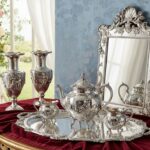The Vintage Shawl Revival: From History to High Fashion
Antique shawls and vintage scarves have always symbolized luxury and elegance, and in 2025, the revival of vintage shawls is more prominent than ever. Vintage shawls, once draped over the shoulders of royalty, have become a staple of modern fashion. These historic textiles—rich in embroidery, weaving, and symbolism—are no longer confined to museum archives or grandmother’s closets. Instead, they’re back on runways, in street style, and across Instagram feeds. The revival of vintage shawls is more than a fashion trend—it’s a cultural reconnection. With fashion brands and models incorporating shawls into their ensembles, they are now more popular than ever. These versatile pieces not only carry stories from the past but also provide endless possibilities to enhance modern wardrobes. How did this revival happen? Are shawls still in trend in 2025? These are some of the questions that have been popping up. In this blog, we will explore how 19th-century shawls became status symbols, faded into obscurity, and now reemerge as timeless, versatile fashion statements. Plus, we’ll show you how to style antique shawls in modern ways—without looking like you stepped out of a period drama with our shawl styling tips.

Timeless Appeal Of Vintage Shawls

Antique and vintage shawls hold a rare kind of magic—one that transcends trends, seasons, and even generations. From the intricately embroidered Kashmiri pashmina shawl to a handwoven paisley wrap, shawls of all types and varieties weave a story through their motifs and craftsmanship. Today, they serve not just as fashion statements, but as wearable heirlooms—quietly powerful, uniquely beautiful, and forever relevant.
Also Read: Timeless Allure of Indian Shawls
The Golden Era of Shawls: 19th-Century Elegance
In the 1800s, shawls weren’t just accessories—they were cultural markers and fashion power pieces.
-
Shawls in Royalty
From the courts of Europe to the Mughal palaces of India, shawls were synonymous with prestige. Kashmir shawls, in particular, became prized possessions. Napoleon gifted them to Empress Joséphine. Queen Victoria adored them. The fine pashmina and intricate paisley patterns symbolized wealth and worldliness.
-
From Literature to Lifestyle
Shawls had a literary moment, too. Jane Austen’s characters often wore them. The Brontë sisters described them in fine detail. In Wuthering Heights, Catherine Earnshaw wears a shawl to signify her mood and status.
By the mid-19th century, no upper-class woman’s wardrobe was complete without an array of elegant wraps.
The Decline: When Fashion Moved On
As fashion evolved, so did silhouettes—and shawls fell out of favour.
In the late 1800s, structured outerwear like coats and jackets began to replace draped textiles. Shawls were deemed impractical. Industrialization meant faster, cheaper fabrics and fashion cycles. By the early 20th century, the elegant wrap was associated with the past—a relic of a bygone era.
Why Antique Shawls Are Trending Again
Fast forward to the 2020s, and something fascinating is happening: shawls are back—not as nostalgia, but as bold, beautiful, wearable art.
-
Sustainability with Fashion
As fast fashion’s environmental toll becomes impossible to ignore, more people are turning toward sustainable choices. Antique and vintage shawls offer a way to dress with impact and integrity.
-
Unique Design
Whether it’s a rare paisley pattern or a hand-loomed border, vintage shawls are wearable art. Their imperfections are signs of authenticity, not flaws, and they ensure that no two shawls are ever exactly alike.
-
A Testament to the Past
Every antique shawl carries history in its threads. These textiles once wrapped queens, poets, and socialites; they appeared in paintings, letters, and novels
-
A Desire for Individuality
Modern fashion is personal. People no longer want to look like everyone else—they want clothes that express who they are.
How Shawls Align with Modern Fashion in 2025
In 2025, fashion is about balancing the old and the new. Shawls, especially antique and vintage ones, fit perfectly into this evolving style landscape.
-
Sheer Drapes for Everyday Looks

Sheer fabrics are dominating fashion this year. Antique shawls made from fine muslin, silk gauze, or light netting are naturally aligned with this trend.
-
The Shawl as a Spring Staple
Vintage shawls have become go-to accessories for spring and early summer. The light texture plays well with today’s favoured fashion—low-rise jeans, simple cotton tanks, and clean-lined dresses.
-
Casual Elegance
One of the dominant style codes of 2025 is “casual elegance”—the sweet spot between comfort and sophistication. Vintage shawls offer the perfect accessory to hit that balance.
4. Formal Flair
Shawls are making a comeback in formalwear—but with a contemporary twist. Worn with slip dresses, tailored evening jumpsuits, or sleek gowns, they add just the right amount of drama without screaming for attention.
-
Bold Patterns & Colours
Modern fashion in 2025 thrives on contrast. Neutral-toned wardrobes get elevated with one bold, heritage piece—and vintage shawls are ideal for this. With vibrant paisleys, deep jewel tones, or embroidered borders, they inject instant personality into muted outfits.
Also Read: Vintage Wedding Shawls
Styling Antique Shawls in Modern Fashion
The beauty of vintage shawls is their versatility. Here’s how to wear antique shawls in modern fashion
-
As a Statement Scarf
Wrap a Kashmir or wool paisley shawl around your neck like a scarf. Pair it with:
- A monochrome trench coat for contrast.
- A simple white tee and jeans combo for effortless chic.
- A turtleneck and tailored pants for a city-smart look.
Tip: Fold the shawl lengthwise to highlight the border design.
-
Draped Over the Shoulders
Go full regency-core with a shawl draped across your shoulders. Perfect for:
- Evening gowns and cocktail dresses.
- Layering over jumpsuits or backless tops.
- Weddings or garden parties.
Modern twist: Use a brooch or leather belt to keep it in place.
-
Wrapped as a Skirt or Sarong
Soft wool or silk shawls can be tied at the waist as a skirt. Wear with:
- A crisp white shirt and boots.
- A black bodysuit and chunky jewellery.
- A crop top for a resort vibe.
Tip: Use a wide belt to cinch and define your waist.
-
Layered Over Coats
Wear an antique shawl over a coat. Try:
- Over an oversized blazer.
- Across a leather moto jacket.
- On top of a trench coat for cold days.
Tip: Let the patterns peek out—especially borders and embroidery.
-
Framed or Worn?
Some antique shawls are fragile or museum-worthy. If it’s too delicate to wear:
- Frame sections of the textile as wall art.
- Drape it gently over furniture.
- Use it as a background for fashion shoots or product photos.
Looking For Stunning Shawls To Drape?
Find Insta-worthy, one-of-a-kind pieces—from exquisite pashmina to beautifully embroidered Kani shawls—only at the Giftex Auction.
Stay tuned here and on our website for updates.
Shawls Aren’t Just Back—They Fit Right In
In 2025, fashion is about emotional connection, mindful choices, and self-expression. Antique and vintage shawls offer all three. Whether you prefer sheer and breezy or bold and artistic, there’s a shawl out there that aligns with your look—and says something deeper about how you choose to dress. Far from being relics, these textiles are modern essentials waiting to be reimagined.
Incorporating antique shawls into your wardrobe isn’t just about looking good—it’s about honouring the past and preserving craftsmanship. Each thread carries a legacy. Each motif whispers a story.
So next time you spot a folded wrap in a vintage shop or find one tucked away in a family trunk, don’t pass it by. Drape it. Wrap it. Style it. Revive it.
Because the shawl never really went out of style—it just waited for us to catch up.






